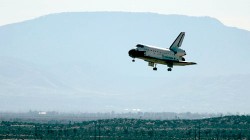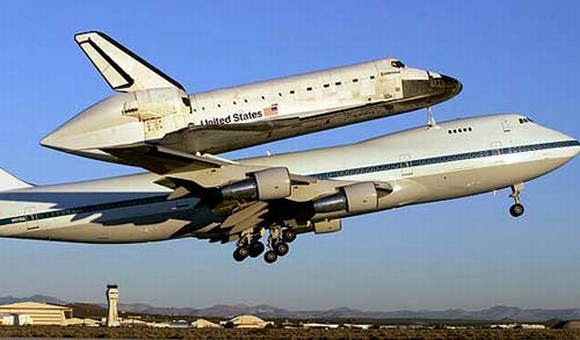[/caption]
Update: Space Shuttle Endeavour left Edwards Air Force Base this morning at 7am, after a 10-day stop over in the Mojave Desert, 65 miles northeast of Los Angeles. Have a safe flight to Florida Endeavour, it was great to have you as a guest!
You’ve probably heard this announcement at the airport before: “Flight delayed due to bad weather.” Quickly followed by, “You can’t be serious!” from the red-faced guy behind you, slamming his briefcase to the floor, resulting in an angry hoard of commuters rushing to the ticket desk to blame the airline for the snow storm outside (because the natural phenomenon of snow is their fault).
However, at Edwards Air Force Base in California, another, more patient passenger awaits her flight back to Florida. But rather than the delay being a matter of minutes or hours, Space Shuttle Endeavour’s flight to Florida has been delayed by three days, and counting…
Endeavour had an astounding mission (STS-126) to the International Space Station last month. The shuttle carried a team of seven to perform one of the busiest 16-day orbital stop-overs yet. The crew completed several spacewalks to fix stiff solar alpha rotary joints, upgraded the station modules to accommodate six permanent station crew members and transported some cool educational experiments into space.

So alternative arrangements had to be made to ferry the shuttle back to Kennedy Space Center, and this included a customized NASA Boeing 747 jumbo jet taxi ride (with a fare of $1.8 million). Endeavour will enjoy a piggyback ride atop the aircraft, hopefully taking off first thing in the morning (Wednesday).
NASA is keeping a close eye on the weather front causing the problems; Endeavour was tentatively scheduled to fly home on Sunday, but poor weather between California and Florida pushed the delay further into the week. NASA does not allow the flying duo to pass through cloud or any inclement weather, so they are allowed to be picky about when to fly.
Sources: Space.com, LA Times, Florida Today


This is amazing! 😀
I bet that 747 handles like a hippo with wings carrying the shuttle on her back.
Which is why it”s never made sense why they just dont launch from California. Mid 70’s, no clouds today.
Rockets launching in an easterly direction need less fuel in order to reach space as they make use of earth’s rotation speed. For the same reason it’s best to launch close to the equator.
For safety reasons it’s best to launch over water instead of inhabited land.
Thus the most southern east coast of the US (i.e. florida) is the best place to launch from despite the obvious weather problems.
For the same reasons Europe’s launch site is located in french guyana, south america.
I understand the equatorial argument, but it’s not that much of a difference, it’s not like the Cape is in the keys or anything. As for population, there ain’t nothin’ at Edwards. Just like having Houston run things, I bet it has more to do with politics and Senators making sure a part of the budget gets to their home state.
EdF
“As for population, there ain’t nothin’ at Edwards.”
When they launch the shuttle in Florida, it’s traveling over the ocean, as well as traveling up towards the space station. The jettison of the boosters happens over the middle of the ocean, and they have to go find the things.
If it launched in California, it would travel across a lot of the United states as is went up. It would cause a lot of damage if it came back down, and the boosters would have to land somewhere, and they are only designed to land in the water.
On the other hand, it was originally intended to have polar shuttle launches out of Vandenberg AFB. You can launch over water to the south from there.
To do the same from the Kennedy Space Center would mean aborts and SRBs coming down on South Florida, Cuba or South America…
The only manned suborbital flight the then-Soviets had was a Soyuz launch that had a malfunction at stage seperation, and the craft had to descend before reaching orbit. I gather that the crew required multiple assurances that they would not come down in China, as their launch trajectory passes just north of the border, so as not to overfly and possibly drop lower stages there. (and they take somewhat of a performance hit by doing so.)
Israel launched its first satellite west across the Mediterranean, not just because it’s a natural launch range, but because it had to. Working *agianst* Earth’s rotation caused them a *major* performance penalty, but the best directions would mean dropping stages on countries already, um, unfriendly to them.
Until we have singler stage and/or flyback first stage RLVs, this kind of thing will be a necessary consideration.
can someone please PLEASE tell me how this things flies, but more importantly, how they get the shuttle on the top of the plane??? really, this is incredible to see! hooray for science and technology.
It maybe an ungainly looking airplane, but it flies because, well,it’s an airplane:
As for how they get them together…
http://www.dfrc.nasa.gov/Gallery/Movie/747_SCA/HTML/EM-0064-02.html